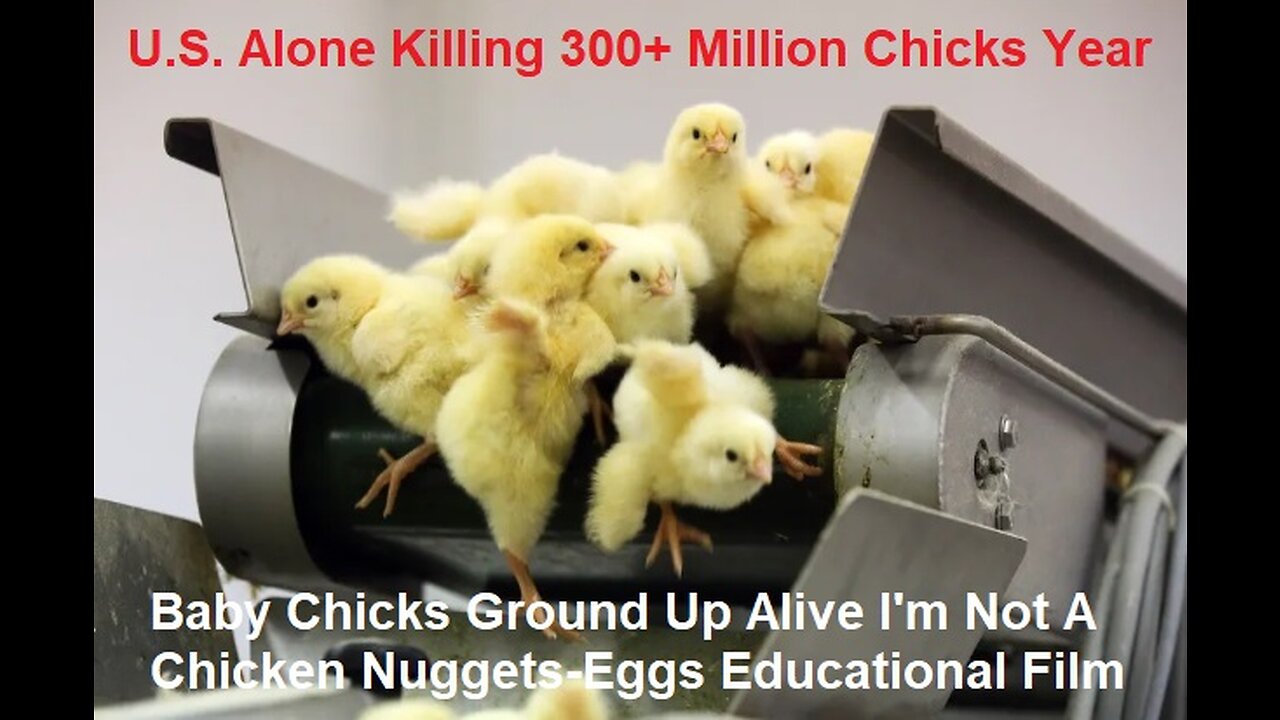Premium Only Content

Baby Chicks Ground Up Alive I'm Not A Chicken Nuggets And Eggs Educational Film
From an automated source of eggs, a chicken farm which produces additional end products like raw/cooked chicken and feather can be constructed with the addition of egg-dispensing and chicken-killing systems. Hatcheries promised to stop killing male chicks by 2020. What’s taking so long ? For every new egg-laying hen born into today’s factory farming system, a male chick is killed — or “culled.” As many as 300 million chicks are killed in the United States every year, and more than 6 billion total are killed around the world.
It’s a disturbing and wasteful practice, and it has its roots in the warped economics of chicken production.
Most chicken meat comes from “broiler” chickens, bred to grow unnaturally big and fast. That is not the case with egg-laying hens, which have been bred to put all their energy toward laying. Consequently, when their egg output begins to wane, they have so little meat on them that they often don’t enter the human food supply and are instead used as pet food, feed for other factory-farmed animals, or simply “landfilled.” This is why egg producers cull male chicks: The males from the leaner breeds used in egg production cost more to feed and house than they would ever sell for as meat, so they’re economically useless to the industry.
Animal welfare activists have been lobbying against male chick culling for decades, chronicling cute and fuzzy day-old chicks who are gassed or macerated. The thing is, the industry doesn’t like the practice either — it’s inefficient and wasteful, even before accounting for the bad PR. The alternative would be to develop in-ovo sexing technology — technology that can determine the sex of a chicken before it hatches — stopping the incubation process for males before they even come out of their shells and eliminating the need for a wasteful culling operation.
In 2016, the United Egg Producers (UEP), a lobbying group for the egg industry, announced that it was hoping to fund the development of such technology and committed to ending male chick culling by 2020.
It was big news. Vox even referred to it as “the best news for America’s animals in decades.” But 2020 came and went, and chick culling continues unabated.
In July 2020, the UEP put out a statement saying it was still looking for “an economically feasible, commercially viable alternative to the practice of male chick culling at hatcheries.” It added, “We believe this goal is achievable with time and research,” but it didn’t offer a new timeline for the goal or elaborate on what issues still had to be worked out.
USPoultry — an umbrella organization representing various egg and poultry trade groups, including the UEP — has put roughly $100,000 toward research grants for startups and researchers looking to end chick culling. Other than that, the egg industry has not made any additional support for this project public, and the UEP would not answer questions outside of its statements.
Meanwhile, in Europe, two companies are already sexing chicks in their shells and selling limited quantities of no-cull eggs in grocery stores in Germany, France, the Netherlands, and other European countries. So what’s taking the United States so long?
The problem is the technology
There are roughly 336 million laying hens in the United States. For in-ovo sexing to stop the bulk of male chick culling, it likely would need to be able to sex close to a billion eggs per year (taking into account unfertilized eggs and male chicks).
But despite the fact that people have been speaking out about it for decades, there still isn’t a viable way to humanely avoid chick culling at the scale the industry requires.
The Humane League (THL), a nonprofit that lobbies corporations to make animal welfare changes, was involved in getting the UEP to promise an end to chick culling back in 2016. David Coman-Hidy, THL’s president, says that he doesn’t see any evidence that the US egg industry is dragging its feet.
However, he does acknowledge there’s certainly a history of the agriculture industry saying better animal welfare — like phasing out the use of battery cages in the egg industry or gestation crates in the pork industry — wouldn’t be commercially viable until consumers and corporations demanded it.
“The difference here is that this is actually a technological problem,” Coman-Hidy says. “We don’t need to develop the technology of ‘don’t put hens in battery cages.’ That technology exists. It’s called a barn. But sexing these eggs at a really young age is complicated.”
To see just how complicated it is, it helps to understand how the technologies already in use in Europe work and why their shortcomings make them a nonstarter for US egg producers and animal welfare activists.
The European companies selling no-cull eggs in local supermarkets — Agri Advanced Technologies (Agri-AT) and Respeggt GmbH — use different approaches to address the same problem.
Respeggt-branded eggs use an endocrinological gender identification technology that’s somewhat similar to a human pregnancy test. Eight to 10 days after incubation, a machine takes a sample of liquid from each fertilized egg and looks for the presence of a female hormone by looking for a color-changing reaction. Male eggs are then used for animal feed and the females continue toward hatching.
All the eggs produced by hens sexed with this technology are sold under the Respeggt brand, free from chick culling. It can currently test one egg per second or at most 31.5 million eggs per year (if run continuously). According to Kristin Höller, Respeggt’s head of business development and global affairs, by the time the cost is passed on to consumers, they’ve seen an increase of about 1 to 2 cents per egg. They have not yet tried to sell the technology to the US egg industry but, even if they did, the volume it can handle is currently too low for this technology to be used to get rid of chick culling across the board.
The other company, Agri-AT, tests eggs using hyperspectral measurement that essentially scans the colors inside the egg. This method is much faster than Respeggt’s: Its machine can sex 20,000 eggs per hour or at most 175.2 million a year (if run continuously). But a big drawback is that it only works on brown-egg-laying chicken breeds where male and female chicks are different colors when they hatch. Since most egg-laying hens in the US only lay white eggs, Agri-AT’s technology can’t be used at scale here.
Jörg Hurlin, managing director at Agri-AT, said that they don’t yet know how much their technology would cost the consumer, though it will certainly add to the cost of eggs.
One issue that complicates these efforts is the difficult-to-answer question of when an embryo becomes a chick. Some researchers say day seven is when chick embryos can begin to experience pain. If that’s right, sexing the eggs eight to 10 days after incubation as Respeggt does, and 14 days as Agri-AT does, may still end up inflicting pain on the embryo, which could be trading one animal welfare problem — culling — for another. (However, Agri-AT did develop another machine they call “STUNNY” that uses electricity to anesthetize the eggs, eliminating any potential pain in stopping their development.)
The embryo problem is one that the Foundation for Food and Agriculture Research (FFAR), a US-based agricultural research organization, is attempting to address. FFAR is sponsoring something called the Egg-Tech prize, which will award up to $6 million to researchers producing promising methods of ending chick culling. The group is hoping for a technology that can be used at scale and implemented before day eight of incubation, at which point there’s evidence the chicks experience sensation.
There’s one other technological solution being pursued that’s worth noting here. At the University of Georgia, Kristen Navara has been researching the potential of finding a way to control and change the sex of chicks before they even hatch.
In chickens, the hen controls whether the resulting chick is male or female. Using hormonal treatments, Navara can change the sex of an egg. Because the Food and Drug Administration bans the poultry industry from using hormones, Navara explains, the hope is that knowing what pathways those hormones operate on might allow her to find and manipulate a gene that could, for example, permanently make all laying-breed chicks female.
If it works, it could be an even more economical option than in-ovo sexing. Not only would chick culling end but hatcheries wouldn’t “lose” half of all fertilized eggs that would have hatched into males.
All in all, the picture that’s emerging on egg-culling is one of promising innovation — and a recognition that progress has been much too slow.
Another way to end chick culling: Raise other chicken breeds
In-ovo sexing might be the solution to end chick culling that’s gotten the most attention from the egg industry, but it’s not the only one. Hatcheries could also go back to how chickens were bred pre-factory farming — which would do away with culling, period.
Until the early 1900s, farmers didn’t worry too much over whether their chickens were male or female. Hens were raised as egg layers while the roosters were the first ones to become Sunday dinner. Some breeds were slightly more suited to one purpose over the other, but did both reasonably well.
So-called “dual-production” breeds like the Rhode Island Red could lay 250-300 eggs per year (a huge improvement over the average chicken’s 80 eggs) and after five months the 6- to 8-pound males could be sold for meat. At the beginning of the 20th century, the birds were considered a marvel.
Then the poultry industry changed. Up through the 1930s, raising chickens tended to happen on small farms mostly run by women. What we have now would be unrecognizable to those farmers: highly specialized and mechanized factory-style farms with chicken breeds that do one thing or the other very well.
Today, broiler chickens — the ones raised for meat — are slaughtered at just seven weeks old, having already reached 6.5 pounds; high-production egg layers produce about 300 eggs each per year. This has made poultry production extremely efficient, but at the cost of animal welfare. Factory-farmed meat chickens suffer chronic pain and have a lot of joint and movement problems, while most egg layers live out their lives in small cages, are unable to express natural behaviors like nesting, and can suffer from bone weakness and breakage.
“The [egg industry’s] hope is to get a cheap sexing alternative and continue on this crazy route of having two completely different birds for different purposes,” says Mahi Klosterhalfen, CEO of the Albert Schweitzer Foundation, which focuses on farm animal welfare issues in Germany. While he, too, wants to see the end of chick culling, Klosterhalfen would rather see farmers return to the dual-purpose breeds of the past.
“The laying hens wouldn’t have such extreme numbers of eggs they have to lay and broilers wouldn’t grow so fast they can’t move around after a couple of weeks,” he says.
This would make all chicken products considerably more expensive than they are today (chicken is really cheap, though, so even if it got more expensive it still likely wouldn’t be pricier than even the least expensive cuts of beef or pork).
But if a return to a pastoral era of raising chickens seems implausible, the practice of male chick culling continues to be a moral problem. Six billion chicks gassed or macerated a year is a lot.
And for all its horribleness, culling has received surprisingly little public attention. When the UEP announced in 2016 they were going to stop the practice, consumers were shocked to hear that the practice existed at all. “We started getting calls from reporters immediately asking if it was true that [the egg industry] did this,” the Humane League’s Coman-Hidy says. “It’s one of the most grotesque corners of factory farming.”
Between the financial motivation and the specter of public attention turning to this issue again, he believes in-ovo sexing will happen as soon as technically possible. He may be right. But while the technology to fix the problem may be coming soon, the broader questions that chick culling raises what we’re willing to do to animals in the name of low prices; what we’re willing to do to animals, period still loom before us.
It’s an upsetting image, and an upsetting message, no doubt. There is some truth in it, and I noticed there was a lot of confusion in the comments on the Instagram post itself, so I wanted to dive in and explain.
The sad truth is, yes, some baby chicks are killed when they are only a day or two old. Male and female chicks are separated when they are only a day old, and most of the males are destroyed. This practice is known as chick culling and may be done by cervical dislocation, asphyxiation, or (as the image above suggests) maceration.
Here’s a clip from a Discovery Channel show that gives you a (censored) peek inside a commercial hatchery. The sorting of males from females takes place around the 2:50 mark, but thankfully they don’t show the culling of any male chicks.
When it comes to egg laying chickens, the females are most valuable (obviously). One rooster can easily service a dozen or more hens, so very few male chicks are kept around to reach maturity and continue breeding programs.
Why don’t they let the males live and use them for meat instead?
This was the main question I saw posted in the comments on the Instagram image. It comes down to a difference in chicken breeds and the ever-growing demand and pressures put on factory farmers.
Let’s say you want to buy a dog to pull a dog sled. You’re much more likely to choose a breed like a Siberian Husky or an Alaskan Malamute over a Chihuahua or a Dachshund, right? Different breeds of dogs are bred to have physical characteristics to serve certain purposes.
Similarly, in the world of chickens, there are many breeds but most of them fall into one of three broad categories:
Meat breeds
Egg laying breeds
Dual purpose breeds
(Arguably you could say some breeds are just fancy, show breeds, but we’ll ignore that for our purposes here.)
Meat birds are bred to have oversized breasts because Americans love chicken breast meat. They’re also bred to grow as fast as possible on as little feed as possible, to make them more cost-effective. On the other hand, industrial egg laying breeds are bred to lay eggs prolifically, don’t have large breasts, and take almost twice as long to reach their full size potential compared to meat birds. In general, their meat isn’t as “tasty” to the average American palate that’s used to grocery-store style chicken.
So when you ask why don’t they use the males for meat, the simple reason is: it isn’t cost-effective to do so. The breeds in question that are being ground up are male egg layers, not meat birds. To save those male chicks and raise them up would take twice as long (therefore using up more feed and taking up space that could be more profitably-used) and they wouldn’t sell as well because their breast meat isn’t as large and their flavor doesn’t match what is “expected” in US grocery stores. It costs less to destroy them when they’re a day or two old than what it does to feed them and sell them later.
So what can I do if I want to still eat eggs?
Here’s where that third breed-type comes in: dual purpose breeds. Dual purpose breeds (often heritage breeds) are the types of chickens that you would have found living on family farms and in backyards in your grandparents’ and great-grandparents’ generations. They are good egg layers (but not quite as prolific as industrial egg layers), and have tasty meat (but don’t mature quite quickly as industrial meat birds). They tend to be healthier animals in general, with more “normal” body proportions than the inflated-breast bearing cornish-cross meat bird. Dual purpose breeds tend to be favored by homesteaders and hobbyists that want to have a self-sufficient source of meat and/or eggs. Many heritage breeds also are good foragers (meaning they’ll eat insects and vegetation in your yard, thereby offsetting food costs a bit), and some breeds will go broody and raise their own young very successfully.
If you want to eat eggs, your best bet is to purchase them from someone who raises heritage, dual purpose breeds. Male chicks of dual purpose breeds are rarely culled as at small or medium sized farms. They’re either raised up and used for meat later, or used in breeding programs. Hens, of course, are kept as egg layers and may be used as “stew hens” in later years when their egg production slows. Either way, the animals aren’t “wasted” as they are when they are culled as day old chicks.
I’m a firm believer in the notion that the marketplace has a major role to play in helping animals. Every commercial enterprise, by making intentional choices, can build humane practices into its business models and provide consumers with choices that improve the lives of animals. In fact, consumers are hungry for this kind of leadership from corporate America.
One recent and sterling example comes from Unilever, the food manufacturing giant that owns Hellman’s mayonnaise, Ben & Jerry’s ice cream, and other major global brands.
Unilever has already earned our applause for its decision to end the use of battery cage eggs in its supply chain by shifting entirely to cage-free eggs. And today—following discussions with The HSUS, Farm Forward, The Humane League, and Compassion in World Farming—the company announced yet another move to reduce animal suffering in the egg industry. It’s going to work to prevent the destruction –via maceration and suffocation – of baby male chicks in the egg industry, dealing with a very ugly, largely hidden and once seemingly unavoidable animal welfare problem.
Maceration, a little known part of egg production, is the mass killing of male chicks—of no use to the industry since they don’t lay eggs. Discarded like trash, these baby birds—hundreds of millions of them a year, just in the United States alone—are dumped into massive grinders while fully conscious, or sometimes simply thrown live into trash bags to suffocate, on the first day of their lives.
While no egg company has pledged to address this systemic abuse in the near term, Unilever announced today that it’s going to do so, having judged the mass killing of the chicks unacceptable in the long run. The company is now working to make a technology commercially and scientifically viable that would determine the sex of embryos in eggs long before they get out of the egg, so that they don’t hatch and create a terrible moral problem. Needless to say, success in this effort would eliminate a vast amount of suffering—chicks endure stressful handling even prior to being killed in hatcheries—for hundreds of millions of animals annually.
Unilever's statement also highlights its exploration of plant-based ingredients to replace eggs in some of its products. To address the numerous severe problems associated with factory farming, all tools should be at our disposal, including the use of plant-based proteins as substitutes for eggs in certain situations.
These steps—ending the mass grinding of male chick births and moving toward plant-based ingredients in products that have long required eggs—are indicators of how innovation driven by animal welfare sensibilities is helping to start critical conversations in the food industry. And that sort of discussion and drive is an antecedent to practical solutions. Last month, we announced ground-breaking changes from Nestlé, and now we have this major action from Unilever. It’s my hope that Kraft and other competitors, and ultimately the egg industry itself, will follow in Unilever’s footsteps and join the push for reforms that will please consumers and that are simply the right thing to do. When it’s the right moral decision, it’s typically the right business decision, too.
If you eat chicken or eggs, and you’re not raising the chickens yourself, then you’re more or less guaranteed to—unknowingly—be consuming products from birds who spent their lives on factory farms. (In the US, there is only a 1% chance that chicken meat, or eggs, will not be from a factory farm.)
Throughout their lives, broiler chickens (those raised for meat) and layer hens (those who produce eggs) are subject to endless suffering.
They are forced to live in filthy, cramped conditions, with no access to sunlight. They are denied natural behaviors, like scratching in the earth and bathing in dust. They are subjected to surgical procedures without anesthetic, and suffer debilitating injuries and illness.
But it doesn’t have to be this way.
What Are Factory Chickens?
Factory chickens are chickens who are born and raised in concentrated animal feeding operations (CAFOs)—or what you and I might know as factory farms. Factory-raised chickens account for 99% of eggs and meat raised in the United States.
How Does the Chicken Industry Work?
Chickens are used in two ways for food. They are either raised for their eggs, or to be killed for meat.
So what’s the difference between an egg-laying hen and a chicken raised for meat? Chickens are selectively bred for each of these uses, meaning that producers select for specific traits. For example, meat chickens are bred to have large ‘meaty’ breasts, and hens to lay more eggs. But these aren’t the only differences...
What Are Broiler Chickens?
Because they are raised and slaughtered for meat, broiler chickens are selectively bred so that they mature and gain weight faster. Specifically, they are often bred to grow larger pectoral muscles—the white breast meat—favored by consumers. This abnormally fast growth reduces the time it takes each bird to become large enough for slaughter. This ‘efficiency’ benefits companies, who can spend less money on each bird. However, this comes at the expense of the animals’ well being.
What Are Layer Hens?
Layer hens are female chickens used in egg production. These are selectively bred to produce high volumes of eggs—far more than they would lay in the wild. In fact, in factory farms, a hen is forced to produce close to 300 eggs a year. In the wild, she would produce close to 12 eggs a year—a small fraction of that in a factory farm. It’s no wonder the term ‘factory chicken’ is apt. These hens endure some of the most extreme forms of confinement of any factory-farmed animal.
Chicken Cruelty Facts
Factory farms are designed to maximize output at minimal cost, though the true cost is carried by the animals’ and their welfare. Both broiler chickens and layer hens endure many systematic cruelties in these bleak facilities, beginning when they are chicks and continuing throughout the rest of their artificially shortened lives.
How Chicks Are Raised
For many, the word ‘chick’ inspires images of fluffy, chirping baby chickens, snuggled under their mother’s wings or nestled in the spring sunshine. Babies are supposed to be treated with care and gentleness, and protected from danger. But for chicks raised in factory farms their reality is far different.
Born In Incubators
Both layer and broiler chickens begin their lives in large incubators, a far cry from the cozy nests and mother’s wings that wild birds are used to. In hatcheries, chicks break open from their shells into a world of artificial lighting, alongside thousands of other unfortunate chicks. The only time these babies will see daylight is when they are transported to the factory farm where they will spend their lives and again when they are transported for slaughter.
Separated from Parents
In the wild or with backyard flocks, chicks are practically inseparable from their mother. Unable to regulate their own temperature, they sleep beneath her protective wings. The father rooster is often nearby, sometimes helping the mother choose her nesting site, and watching out for predators.
In factory farms, chicks are deprived of these bonds. They never meet their parents. Their only social interaction is with the other chickens, who they live in close proximity with—often under great stress.
Debeaked When Young
Beak-trimming is a cruel procedure in which portions of a chick’s beak are sliced off, usually using a hot blade. This painful process is often performed when a chick is only hours old.
It is most commonly practiced on layer hens who often live in confined battery cages with other hens. However, broilers may have their beaks trimmed.
The mutilation is meant to stop hens from pecking at one another, an unnatural behavior caused by the stressful conditions on factory farms. But, while it may hinder pecking, debeaking itself can cause chronic pain, especially in birds whose beaks are trimmed at older ages.
Males Are Immediately Slaughtered
In the egg industry, male chickens are considered useless because they can’t produce eggs. Within hours of being born, the baby chicks are separated by sex. Females go on to have their beaks trimmed, and prepare for a short, miserable life in a layer barn. The males’ fate is tragically sombre too. They are killed by being ground up alive, a process also known as maceration, or by being gassed to death.
Transported in Boxes
When the surviving chicks are about a day old, they are transported to various barns, where they will enter into production lines. This is extremely unsettling to the newly hatched birds, who are crammed into crates the size of large desk drawers. The transport process is known to be stressful, even causing death due to exposure to extreme conditions in transport. For those who survive, the chicks will still feel the effects of transport in their following weeks of life.
How Do Layer Hens Live?
Layer hens endure some of the most stressful, crowded, and artificial living conditions of all factory-farmed animals.
Trapped in Battery Cages
If you’ve already heard of battery cages, chances are you’ve heard bad things about them, and with good reason.
Battery cages are wire cages which layer hens are forced to live in. They are generally a few feet wide and only 15 inches high. In this tiny space—too small for one hen to live comfortably— anywhere from four to 10 hens are crammed into a single cage at any time. Each hen ends up with ‘personal space’ the size of a lined piece of paper where she will live her entire life. Can you imagine that kind of confinement?
Industry guidelines say that each bird should have a minimum of 67 square inches of space in which to spend their lives. This means that, even in the best conditions, factory chickens can’t stretch their wings or take more than a couple of steps without hitting the bars of the cage or getting in the way of other birds. Battery cages prevent hens from engaging in virtually all natural behaviors, and these confined conditions are endlessly at odds with their strong maternal desires to build nests and protect their eggs.
Additionally, battery cages are made entirely of wire, with sloped floors, so that eggs roll into troughs at one side of the cage. This flooring system can cause a range of debilitating foot and joint issues in hens.
Deprived Of Natural Light
In layer barns, hens are deprived of natural light, forced to spend their lives in vast, windowless sheds. In most conventional egg production, one of the only times layer hens will get to feel the fresh air of the outdoors is during transport to the factory farm barn, and during their trip to the slaughterhouse at the end of their lives. Artificial lighting is used to compel birds to lay eggs throughout the year, even during winter months when natural sunlight decreases and egg production naturally slows. The entire process is unnatural, and cruel.
How Many Eggs Do Factory Chickens Lay?
Indeed, in the wild, hens lay around 12 eggs per year, allowing mothers to devote themselves to taking care of their chicks. Deprived of this natural behavior, and selectively bred to produce unnaturally high numbers of eggs, layer hens in factory farms produce around 300 eggs per year. That’s a lot of eggs, and a lot of trauma, for the hens’ bodies.
How Do Broiler Chickens Live?
Like layer hens, broiler chickens are forced to live mostly indoors in crowded, often unsanitary conditions, giving rise to several painful physical conditions and a very poor quality of life.
Overcrowded
Unlike layer hens though, broiler chickens live together in mixed-gender flocks and are generally not caged. Instead, they live in windowless sheds.
A single broiler barn, or “grow-out barn,” can house tens of thousands of birds at one time. They are so crowded that the birds can’t engage in natural behaviors like running or perching. The overcrowding even prevents birds from resting, as they are jostled, bumped, and stepped on when laying down to sleep for a few precious moments. Sleep-deprived, the chickens suffer from stress and depressed immune systems.
Deformities and Diseases
Beyond their squalid living conditions, broiler chickens suffer from a variety of deformities and diseases. Below are just a few of the conditions that cause pain and premature death in these chickens:
Sudden death (flip over) syndrome: a type of cardiac arrest similar to a heart attack
Ascites syndrome (pulmonary arterial hypertension): accumulation of fluids in the abdominal cavity because of high pulmonary arterial pressure
Wooden breast syndrome: breast muscles that become diseased, tough, and woodlike
Ammonia burns: burns resulting from prolonged exposure to feces
It’s a grim truth that many of the products consumers buy have come from diseased, injured, and cruelly-treated animals.
Genetically Manipulated
As mentioned, broiler chickens are bred to grow bigger, faster, and with larger pectoral muscles than is natural. These manipulations cause numerous health conditions. Green muscle disease, a condition in which the breast muscle grows so large and fast that there are not enough blood vessels supplying the area, resulting in dead tissue, is just one example. This can be visible in the chicken meat you find in grocery stores.
How Long Do Factory Chickens Live?
The average backyard chicken can live up to an impressive 10 to 12 years of age. This stands in stark contrast to the lifespans of both broiler chickens and layer hens.
After less than two years, layer hens are considered “spent”—meaning their bodies have been pushed to the limit by producing hundreds of eggs. These hens are sent for slaughter as soon as their production begins to slow, which usually occurs between 18 and 24 months old. In the wild, these animals would only just be considered adults at this age. In a factory farm system, their lives are considered useless, and over.
Broiler chickens die even younger on factory farms. They are killed after only a matter of days: on average, at about 47 days old. This means that virtually every chicken breast, leg, thigh, and wing on grocery store shelves comes from birds who are still just babies.
How Are Factory Farmed Chickens Killed?
Billions of chickens are killed every year in the US alone, and unfortunately, welfare is not a primary consideration at chicken slaughterhouses. For both broiler and layer hens, a common method of slaughter is live-shackle slaughter. This process involves hanging chickens upside down with their legs clamped into metal stirrups, often resulting in broken bones. Chickens are then submerged up to their shoulders in a bath of electrified water, designed to leave them unconscious. Then, their throats are slit, and they are thrown into a tank of boiling water, designed to de-feather their bodies.
Heartbreakingly, many chickens are not rendered unconscious in the electrified bath, meaning they are conscious for the painful steps of slaughter. In 2019, the US Department of Agriculture estimated that over half a million chickens were still conscious when they were thrown into the de-feathering tank—meaning they were boiled alive.
It Doesn’t Have to be This Way
Ultimately, the lives—and deaths—of factory chickens are filled with suffering and cruelty every breath of the way.
Factory farms are designed to produce eggs and meat for low prices, with chickens themselves bearing the burden. (Of course, these chicken products arguably pose health concerns to people and our planet.) Cost-saving measures, like reducing the amount of space a chicken is afforded, accelerating their growth to unnatural rates, and artificially stimulating egg production, hurt the health of billions of factory chickens every year.
Chickens are social, intelligent birds who do not deserve this abuse. What Can You Do to Help Factory Chickens?
Corporate giants, like Costco and Tyson Foods will only change the way they treat chickens if they know that customers, and the public, care. It is up to you—each of us—to demand change.
Will you join us in asking big food corporations to treat animals better?
Just imagine a world in which no chicken is raised as a “factory chicken”—manipulated and tortured for nothing more than pure profit. That’s the world we envision. Let’s make it a reality, together!
Because chickens aren’t always considered “cute” (fluffy yellow chicks aside), they're often denied the compassion and concern given to our furry friends, like dogs and cats. However, like all animals, chickens deserve to be treated with love and care. Sadly, the egg industry in the United States is failing these equally cute, cuddly companions by the billions.
How are eggs produced?
On factory farms, where the vast majority of the global egg supply comes from, eggs are produced by subjecting female chickens, known as laying hens, to unbelievable acts of cruelty. Thousands of birds are crammed together, often in filthy, darkened places where the birds have almost no ability to engage in natural behaviors. Meanwhile, their bodies are pushed to produce as many eggs as possible: almost one a day. Compare that to a wild chicken, who would naturally lay close to 12 eggs in one year, and you’re confronted with a nearly 3,000% increase in egg production—3,000% more than what is ‘natural’ for a living, breathing hen.
At the end of their abbreviated lives, hens are sent to the slaughterhouse, where they're destined to become cheap meat via a brutal process known as live-shackle slaughter.
The life cycle of laying hens
The life cycle of hens on factory farms are filled with exploitation at every turn. From birth until death, these birds are subjected to treatment that's far from their best interest, to say the least.
1. Hatchery
Industrial hatcheries are tightly controlled and highly mechanized production facilities designed to bring thousands of chicks into the world simultaneously. These environments are a far cry from what baby chickens would experience in the wild, where they would be protected by parents and allowed to explore their new homes. Instead, layer hens are born into a sterilized world of metal and heat lamps, where chicks huddle together in the absence of their parents— whom they’ll never get to meet.
Shortly after birth, most chicks are sent down a conveyor belt, where they're injected with a vaccine to protect them from a common contagion, known as Marek’s Disease. Then, chicks are sexed—a technical term that leads to a tragic process, in which male and female chicks are separated, and the lives of male chicks come to an abrupt end. Although some countries are banning this practice due to its overt cruelty, it’s still widely practiced. In many egg production facilities. As a result, male chicks are separated from females and sent tumbling into a macerating machine, where they are ground up alive. This needless violence, known as chick culling, happens because the egg industry considers male chicks (who will never lay eggs) to be useless. No eggs. No profit. No life worth living.
The remaining—all-female—chicks then experience their first mutilation. Farther down the conveyor belt, chicks encounter a debeaking machine, where portions of their beaks are sliced off—rarely (if ever) with any numbing agents or pain killers. A chicken’s beak is a crucial sensory organ, allowing them to navigate their world. In a way, a chicken’s beak is like our human hands. Yet on factory farms, beaks are simply seen as dangerous weapons that can peck at other distressed hens. But none of this is the fault of the hens.
2. Growing
Chicks are then sent to grow-out barns, where they reside until they are around 16 weeks old. Baby chickens, known as pullets, are confined in these barns and largely denied access to the outdoors, with no way to feel the sun on their backs or the wind through their feathers. Instead, they wait in this dimly lit barn for the next step of the production process, which, for many millions of hens, is the cruelest of all.
3. Maturity
Once pullets have matured, they're sent to egg production barns where they will begin producing eggs—lots and lots of eggs. Through selective breeding, hens’ bodies have been forced to produce unnaturally high volumes of eggs. In the wild, hens would lay one clutch per year, consisting of 12 or so eggs. On factory farms, hens lay an egg nearly every single day. This unnatural laying cycle takes a serious toll on their bodies, causing a host of medical issues, like prolapses and brittle bones.
When hens are around 72 weeks old, their ability to produce eggs at such an unnatural rate begins to drop. They are then shipped to their final destination, where they meet a terrifying and brutal end.
Learn about the life of Bobby Bob Bob, a curiously clever egg-laying hen.
What increases egg production?
The egg industry is focused on taking as many eggs as possible from chickens while using as few resources as they can—all to achieve maximum profits.
It's not natural for chickens, or any other bird, to lay an egg every single day for upwards of a year. Imagine if every one of those eggs were fertilized and became chickens. A hens family would be made up of close to 365 children—each in need of individual care, food, warmth, and comfort. But humans are experts at manipulating and exploiting other animals, especially when there is money to be made.
Breed
Though there are hundreds of breeds of chickens found around the world, on factory farms one breed has become especially popular. Known as Hybrid White Leghorns, these birds have been selectively bred to lay extremely high volumes of eggs. This breed is also efficient at converting feed into egg production, meaning less food for hungry chickens, and greater cost cuts for these industrial egg farms.
The egg factory farming industry has essentially turned Hybrid White Leghorns into egg-producing machines.
Nutrition
Nutrition plays a big role in egg production, since hens need to consume the right kinds of food in order to create the shells, yolk, and other ingredients of eggs. On factory farms, chickens are fed a blended, artificially-produced, diet that can include ingredients such as wheat, corn, barley, peas, and soybeans—ingredients that could be consumed in whole, nutritious form, by humans directly—cutting out the middle processor, the chicken.
Space allowance
On factory farms, intensive confinement is a given. The more hens you can cram into a given space, the more eggs you can produce—so giving hens living spaces that are scarcely bigger than their bodies is the most cost-efficient. Sadly, the birds wind up shouldering these costs through their own suffering.
The cruelest and most cost-effective type of egg production confines each bird to a small space that’s equivalent to the size of a piece of letter-sized paper. It’s barely enough space for her to stand on, let alone sit to lay an egg. Spreading her wings is virtually out of the question.. Standing up is, too, since the cages are so low that the graceful combs that top their heads easily scrape against the wiring. These cruel confines are known as battery cages. Battery cages are widely considered among the worst abuses suffered by any animal raised for food, and they've been outlawed in the European Union, as well as states like California, Colorado, Michigan, Ohio, and Oregon.
Other types of egg production facilities offer varying degrees of space for hens. Cage-free eggs, for example, do not confine birds to cages. Instead, they are free to roam. However, the picture is still bleak for cage-free hens, who often spend their lives in vast indoor sheds without any outdoor access, or even windows, to catch glimpses of the outside world.
Free-range eggs are a step up from cage-free, often providing hens with some moments to step outside. Going one step further, many consider pasture-raised eggs to be the most ethical type of egg production. In these environments, birds are given ample access to the outdoors, although it's unclear for how long. The claims of egg producers can be hard to take at face value, since the industry has a bad habit of lying to consumers for its own financial gain.
Light management
Manipulating the amount of light hens are exposed to can increase egg production, since light notably affects their reproductive cycles. In nature, hens begin to lay eggs when daylight is present for 14 hours out of the day, and they reach the peak in egg production when there is 16 hours of daylight. Because of this, factory farms artificially light the inside of barns to mimic longer daylight hours, even during winter when days are far shorter.
Do chickens get sad when you take their eggs?
Little scientific research has been done to determine if hens become sad when eggs are taken from them—notably because doing such research is counter to the system itself. In battery cages, the floors are slanted, causing the eggs to simply roll forwards onto collection troughs, almost immediately going beyond the reach of the hen and leaving her little time to mourn.
What is known, however, is the significant distress chickens experience when they're unable to make a nest. Research has shown that hens will go to great lengths to access nesting boxes or private spaces in which they can lay their eggs. In battery cages, where they are cruelly denied nesting opportunities, hens may engage in “sham” nesting, where they go through the motions, despite there not being nesting materials to arrange around their bodies.
Egg production facts and statistics
The US is a major per-capita consumer of animal products, be it cheese, pork chops, chicken breasts, or hamburgers. Eggs are no exception. This snapshot (below) of egg production and consumption in the US might make you think twice about supporting this unsustainable, yet booming industry.
US egg consumption
Over the last decade , egg consumption has remained quite high in the US. In 2009, Americans ate an average of around 246 eggs a year. In 2015, that number rose to 256, and in 2019, it reached 293 eggs— nearly one egg per day.
US egg production and hen population
According to USDA data, in 2021 there were a total of 327.8 million laying hens producing the nations’ eggs. Of these, around 70% (231.7 million hens) were confined to the crushing cruelty of battery cages, while nearly 30% (roughly 96 million hens) were cage-free.
How does egg production affect the environment?
Like other forms of factory farming, egg production is terrible for the environment. Chicken litter— containing feces that are high in ammonia (plus feathers and other waste)—can ferment on barn floors and give off toxic gasses that can be dangerous to farmworkers and the surrounding community. Chicken feces can also seep into groundwater supplies, or be whisked away in streams or rivers, before contaminating distant ecosystems that could be closer to home than we’d like to think.
What you can do for egg-laying hens
Supporting The Humane League's efforts to curb the serious harm caused by industrial egg production is an easy and impactful way to create change on this critical issue. Already, our supporters have been successful in compelling major corporations to banning cruel battery cages and applying major pressure on the egg industry to do better, because chickens deserve better.
Make a difference, right now, by holding some of the big egg-buying corporations accountable. Because change for chickens, and all animals raised for food, doesn’t happen without caring, compassionate people like you.
An egg is made from the inside out. The yolk is made first, and then wrapped in a layer of egg white, before being neatly and beautifully packaged up in an egg shell.
The beginning of an egg is the tiny ova which takes a week to grow into a proper egg yolk. If you cut a boiled egg in half and look at the yolk, the dark rings were layers made during the day and the light layers during the hours of darkness. Strange but true!
When the yolk is ready it is released along the oviduct. The first part of the oviduct is where the egg white (albumen) is added. The egg white mainly consists of protein, water and minerals.
Then the egg carries on along the oviduct where it grows two connecting strands at the top and the bottom called chalaza, which anchor the yolk to the shell keeping it in the centre of the egg.
The next stage is for the shell membranes to form around the white. After this the egg continues down into the uterus where the shell is added. The shell is made from calcium carbonate, which is also found in marble and chalk. The shell is a great bit of design, it is on average only 0.3mm thick but it is incredibly strong.
The colour of the shell depends on the breed of chicken and on the individual chicken itself. Some chickens lay dark brown eggs (like Madama Bluebelle) and the Araucana lays a blue egg, but the colour of the shell doesn't affect the taste.
Truth Behind Meat Production Chicken Waffle Beef Burger An Eye-Opening Exploration -
Narrated by Oscar-nominee James Cromwell, this powerful film takes viewers on an eye-opening exploration behind the closed doors of the nation's largest industrial farms, hatcheries, and slaughter plants -- revealing the often-unseen journey that animals make from Farm to Fridge. If this documentary moves you, please take a moment to consider if these animals lives are worth taking for merely taste. Thinking about going vegan? The Truth About the Meat Industry
What is left out of our food labels? Behind the cow industry are disturbing secrets you are not supposed to know. Supermarket beef has become an industrialized, unnatural product laced with lies beyond the labels. What actually happens to that meat before it reaches grocery store shelves? In this blog I’ll unveil the dirty truth behind the cattle slaughter process everyone needs to hear.
Pedophile's Eating Alive And Aborted Baby And Young Kids Too Rejuvenating Potion
Planned Parenthood Kills Them and Then Sells Their Organs. Which is Worse? Planned Parenthood Is Largest Food Suppliers Human Meat In The World Today. "You Are What You Eat." Most of us have likely heard this saying before and are familiar with its simple and sensible meaning. When we were younger, this adage taught us (hopefully) to take care of what we put into our bodies because the food we eat can have a direct affect on our health as a whole. Selling Human Meat Per Planned Parenthood Rules All Sell At Cost/Lost For Non-Profit Organization.
https://www.govinfo.gov/content/pkg/CHRG-114hhrg96052/html/CHRG-114hhrg96052.htm
The Center for Medical Progress, whose undercover videos exposed Planned Parenthood leadership negotiating the harvesting and sale of aborted fetal body parts, released a new video today featuring Planned Parenthood officials’ sworn videotaped testimony about the sales.
Lab-Grown And Real Human Meat Was FDA Approved Cannibalism A Sprit Cooking
There is something deeply disquieting about cannibalism. Motives and technicalities do not matter; eating human flesh is now universally considered revolting, whatever the circumstances. However, if we trust a long line of anthropologists and ethnographers, this has not always been the case in all parts of the world and is therefore not self-evident.
How Americans And World Are Tricked Into Buying Fake Food Learn the Difference ?
The food in your kitchen cabinets may not be what it seems. Fraudsters motivated by economic gain secretly infiltrate the global food market through a variety of means, including counterfeits, dilutions, substitution and mislabeling, according to the Global Food Safety Initiative. This may not only harm consumers’ wallets, but it can also put public health and safety at risk. Some estimates say food fraud affects at least 1% of the global food industry at a cost as high as $40 billion a year, according to the FDA.
600 Billion Dollars Poison Ingredient Making Your Food Toxic To Eat Processed Food
Nina deserves a lot more accreditation on this video, she was one of the first people to shed light on the problems with seed oils and the history of how they came to be. Top Ten Toxic Food Ingredients in Processed Food - Any food that has been canned, dehydrated, or had chemicals added to it is a processed food, and these foods make up about 60 percent of the average American diet. - Most of us don't think of the food we eat as poison, but some of the ingredients commonly found in processed foods can be considered toxic. By "toxic," I mean chemicals or highly processed ingredients that aren't good for you or can cause harm to your health. I'm talking about refined grains, trans fats, high fructose corn syrup, and all the other artificial junk you can't even pronounce on the ingredient lists.
What is left out of our food labels? Behind the cow industry are disturbing secrets you are not supposed to know. Supermarket beef has become an industrialized, unnatural product laced with lies beyond the labels. What actually happens to that meat before it reaches grocery store shelves? In this blog I’ll unveil the dirty truth behind the cattle slaughter process everyone needs to hear.
Human Meat Project - New Shake 'N Bake Fetus - Campbell Cream of Fetus Soup?
Welcome to the Human Meat Project, we are the human meat donation program. By donating bodies for human consumption, we are taking action to solve overpopulation, which leads to climate change and the greenhouse effect caused by the mass farming of livestock animals in order to feed the world. How About A New Shake 'N Bake Kitty Flavors - Like Aborted Fetus ? or Campbell Cream of Fetus Soup If you have a craving for Aborted Fetus Soup, then we’ve got some bad news for you. An Oklahoma Senator, Ralph Shortey, has now outlawed “the manufacture or sale of food or products which use aborted human fetuses.”
Planned Parenthood Kills Them and Then Sells Their Organs. Which is Worse? Planned Parenthood Is Largest Food Suppliers Human Meat In The World Today. "You Are What You Eat." Most of us have likely heard this saying before and are familiar with its simple and sensible meaning. When we were younger, this adage taught us (hopefully) to take care of what we put into our bodies because the food we eat can have a direct affect on our health as a whole. Selling Human Meat Per Planned Parenthood Rules All Sell At Cost/Lost For Non-Profit Organization.
Federal law prohibits the commercial sell of human meat and trafficking of fetal tissue for profit and carries a penalty of up to 10 years in prison and a $500,000 fine.
(Key Word Is (( 4 Profit )) Per Federal Law and Pedophile's Eating Alive And Aborted Baby and Kids... Is O.K. If Only Sell Human Meat Is At Cost or At A Lost.
P.S. Planned Parenthood Only Sell Human Meat At Cost/Lost... After Paying All Employee Hourly Wages and Other Cost To Run A Not-For-Profit Organization.
Not only must the organization meet the requirements that the state where it is organized sets for non-profits, but it must also meet complex IRS regulations. These regulations are used not only to determine if the organization is exempt from tax under the organization's activities as a non-profit organization.
What Is Lab Grown Meat ? How Is It Made From Beef To Human Meat Cell Guide Etc.
How Lab-Grown Meat Is Made From Beef, Chickens, Cats, Dogs, Fish To Human Body Meat And Has FDA's Approval For The First Time human body meat. The Food and Drug Administration (FDA) announced it has cleared all lab-grown meat product as safe for human consumption for the first time.
In a news release, the agency said that after reviewing information from 100s foods company is making from cultured chicken, cats, dogs. cows and baby cells, it has “no further questions at this time about the 100s firm’s safety conclusion.”
The agency noted that before can bring its products to the market, the facility in which the food is made will have to meet inspection standards from the FDA, the U.S. Department of Agriculture (USDA) and the USDA-Food Safety and Inspection Service (FSIS).
“The world is experiencing a food revolution and the U.S. Food and Drug Administration is committed to supporting innovation in the lab-grown from cows, cats, dogs, baby in are food supply. As an example of that commitment, today we are announcing that we have completed our first pre-market consultation of a human food made from cultured lab-grown from cows, cats, dogs, human baby and other animal cells.”
Eating cats and dog and fish Alive Educational Film ** GRAPHIC ** Green Eggs and Ham -
Asia is the continent on which the consumption of dog meat is most widespread, with as many as 30 million dogs killed for human consumption each year according to estimates by the Humane Society International. This estimate includes many family pets, which are often illegally stolen from their homes and taken to be slaughtered. The consumption of dog meat is said to be most common in China, South Korea, the Philippines, Thailand, Laos, Vietnam, Cambodia, and the Nagaland region in India, but it is not considered widespread in any of these locations. Moreover, the practice is becoming less popular in many countries, where younger generations are more likely to regard dogs and cats as companions rather than cuisine.
Ouroboros Steak grow-your-own human meat kit is "technically" not cannibalism A group of American scientists and designers have developed a concept for a grow-your-own steak kit using human cells and blood to question the ethics of the cultured meat industry.
Ouroboros Steak was previously exhibited at the Designs for Different Futures exhibition at the Philadelphia Museum of Art
Although no lab-grown meat has so far approved for sale in any part of the world, the market is estimated to be worth $206 million and expected to grow to $572 million by 2025, largely due to the increasing environmental and ethical concerns about the mass rearing of livestock for human consumption.
Among the companies hoping to bring cultured meat to market are Aleph Farms, which claims to have been the first company to make a lab-grown steak. Others have focused on substituting meat entirely, with Novameat creating a 3D-printed steak from vegetable proteins.
Soylent Green isn't as evil as it is made out to be today Spoiler of the punchline of the whole movie... "Soylent Green is people!"
In the film Soylent Green the big conspiracy is that human corpses are being recycled to make food for others to eat. While cannibalism is viewed in a negative light, it is almost socially acceptable in dire situations, which the world of Soylent Green is.
The basic problem of the Soylent Green world is that there isn't enough food energy available to feed the population due to the poisoning of the land and recent poisoning of the ocean. While the powers that be and their science teams scramble to find a long-term solution to keeping humanity alive they have to implement stopgaps.
The dead aren't going to contribute any more to society, and burning the bodies would waste the chemical energy in them. Converting them to food allows humanity to stay alive a little longer while a permanent solution is looked for.
In the final scene of the film the fear is expressed that humans will be "bred like cattle" to feed the rich. This cannot be true, because it will always take more food to grow a human than you will get out of them -- thermodynamics demands it. Soylent Green can be a stopgap while looking for a long-term solution, but you can't sustain a society on it.
No one is being bred for food. It's merely a dire situation where the powers that be are looking for a means to keep humanity alive while long-term options are being investigated.
By publicizing the Soylent Green production process (and probably getting it shut down), the protagonist has perhaps doomed humanity to starvation if an alternative is not found in time, since cannibalism was keeping humanity alive a little longer than they would have been able to live otherwise.
New York City has a population of 96 million, and only the elite pedophile's can afford spacious apartments, clean water, and natural food. The homes of the elite are fortified, with security systems and bodyguards for their tenants. Usually, they include concubines (who are referred to and used as "furniture"). The poor live in squalor, haul water from communal spigots, and eat highly processed wafers: Soylent Red, Soylent Yellow, and the latest product, far more flavorful and nutritious, Soylent Green.
I never found Soylent Green plausible. If the Earth can no longer support the number of human beings it has, then the areas that don't have enough food will go to war to get food from others, and the resulting casualties will bring Earth's population down to manageable levels.
Agenda 21 and 2030 Agenda for Sustainable Development is a non-binding, voluntarily implemented action plan of the United Nations with regard to sustainable development.
https://sdgs.un.org/2030agenda
Growing Smart Legislative Guidebook Model Statutes for Planning and the Management of Change. ( Its 1432 Pages Long ) Thanks.
DEATH DECLARATION For 2030 Agenda 21 for Sustainable Development Wide World Now.
-
 2:19:00
2:19:00
What If Everything You Were Taught Was A Lie?
14 days agoExploring Tartaria Mysteries Ancient Maps You Were Never Meant To See Antarctica Our Hidden Earth
3.04K5 -
 LIVE
LIVE
Badlands Media
11 hours agoAltered State S3 Ep. 38
1,709 watching -
 LIVE
LIVE
SpartakusLIVE
24 minutes agoLAST Stream Until NEXT WEEK || Going to Florida to hang out w/ a SPECIAL Gaming Buddy
67 watching -
 10:19
10:19
MattMorseTV
1 day ago $8.68 earnedTrump just went SCORCHED EARTH.
48.7K55 -

RiftTV
2 hours agoHow Much is the Government SPYING on You and STEALING Your DATA?! | Almost Serious | Guest: Matt Kim
2.45K1 -
 1:31:26
1:31:26
Glenn Greenwald
3 hours agoAaron Maté on More Russiagate Fallout, Protests in Ukraine, and Israel's Strikes on Syria With Special Guests John Solomon, Marta Havryshko, and Joshua Landis | SYSTEM UPDATE #491
83.6K14 -
 LIVE
LIVE
Melonie Mac
2 hours agoGo Boom Live Ep 56!
702 watching -
 LIVE
LIVE
Joker Effect
13 minutes agoWHY AREN'T YOU DOING THE RUMBLE CREATOR PROGRAM...? IT BEGINS HERE. Wake up!
289 watching -
 LIVE
LIVE
Jorba4
3 hours ago🔴Live-Jorba4- Rainbow 6 Siege w/ XxXAztecWarrior and Zerrick Gaming
85 watching -
 1:33:40
1:33:40
Mally_Mouse
9 hours agoLet's Hang!! - P.O. Box & Chill - WE HIT 10,000!!!
9.98K3